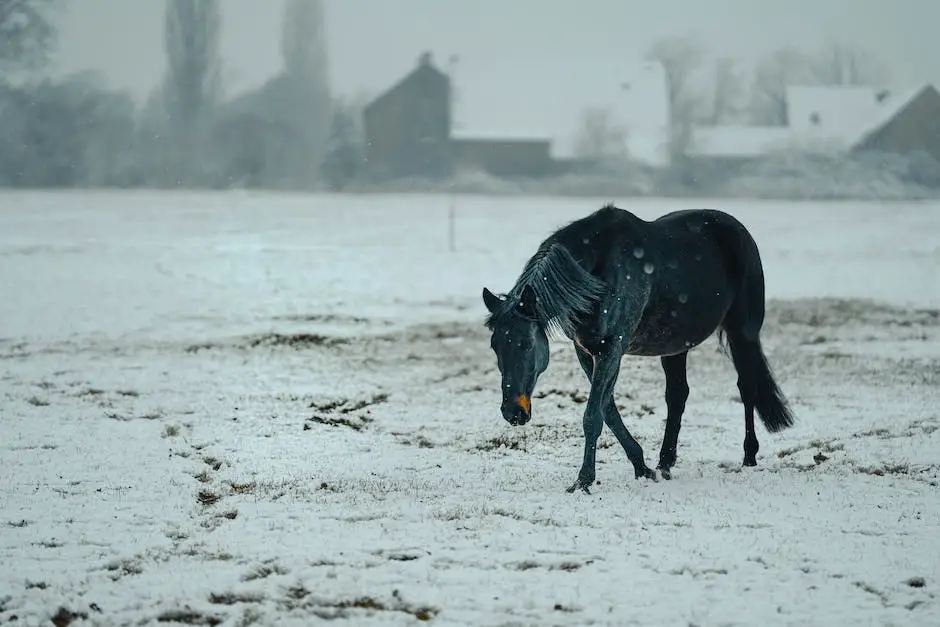In the diverse panorama of equine breeds, cold-blooded horses are often hailed for their equable dispositions and stoic grace. Embarking on the journey of training a cold-blooded horse presents itself as a unique confluence of challenges and rewards. It demands not only an understanding of their serene yet steadfast nature but also an adeptness in fostering a bond steeped in trust and mutual respect. In this discourse, we shall navigate through the intricate tapestry of their temperament, unveiling strategies that resonate with their calm essence. At the crux of our exploration lies the significance of consistent training routines, paving the way for a harmonious alliance between horse and trainer, one carefully woven through the threads of predictability and diligence.
Table of Contents (Horspedia)
Understanding Horse Temperaments
Unlocking the Mysteries of Cold-Blooded Horses: What Sets Them Apart?
Hey horse aficionados! If you’ve ever strolled through a meadow or watched an equestrian event and pondered on the variety of horse temperaments, you’re in for a treat. Today, we’re diving into the enchanting world of cold-blooded horses. These magnificent creatures are more than just gentle giants; they have unique characteristics that distinguish them from their hot-blooded and warm-blooded counterparts.
Understanding the Basics: The Cold-Blooded Temperament
When it comes to horses, the term ‘cold-blooded’ is not about their circulatory system, but rather relates to their temperament and origins. Cold-blooded horses have roots in rugged climates and were primarily bred for hefty, strength-demanding tasks, like farming and heavy hauling. As a result, they developed a calm and even-tempered demeanor, which is pivotal for a working horse.
Physique and Presence
First, let’s talk build. Cold-blooded breeds like the Clydesdale and the Shire boast a sturdy and muscular structure. They tend to have broader chests, powerful hindquarters, and feathering on their lower legs – which isn’t just for show; it’s also practical for protection against harsh environments.
Coloring and patterns vary significantly within cold-blooded breeds, giving each horse its distinct palette. Yet, regardless of color, they all share a relaxed posture and an aura of steadiness that makes them instantly recognizable among equestrian enthusiasts.
Behavioral Traits
The phrase “gentle giant” truly encapsulates the behavior of cold-blooded horses. These equine friends are renowned for their patience and low-key nature. Unlike their hot-blooded relatives, who are spirited and full of fiery energy, cold-blooded horses tend to have a more laid-back approach to life. They are not easily startled and are known for their willingness to work alongside humans without much fuss.
This friendliness and placidity do not imply laziness, however. Cold-blooded horses can be quite industrious and enjoy having a job to do. Their steady behavior makes them a fan favorite for beginner riders and therapeutic riding programs, providing a sense of safety and reliability that’s essential for developing confidence.
Suitability and Uses
Given their calm disposition and strength, cold-blooded horses are perfect for activities that require endurance and poise. They excel in disciplines such as dressage and driving, where precision and a steady pace are valued over speed. These gentle beasts are also ideal for historical reenactments, parades, or any activity where a majestic, calming presence is desired.
Additionally, their versatility shines through in the variety of tasks they can handle. On farms, they can still be found doing the work they were originally bred for, showcasing their powerful build and cooperative nature.
Understanding and bonding with a cold-blooded horse can be a deeply rewarding experience. Embrace the opportunity to work with these delightful giants, and viewers will find not just a functional partner but also a tranquil companion for life’s slower and steadier moments. Whether in the serene ambience of a pasture or the bustling atmosphere of a showground, cold-blooded horses demonstrate that a mighty presence and a gentle heart can indeed go hoof in hoof.
Without a doubt, knowing what makes cold-blooded horses so special enriches the equestrian community’s appreciation for these remarkable animals. So, the next time you encounter one of these serene equine creatures, take a moment to appreciate the subtle strength and calming influence they have brought to the world for centuries.

Building Trust and Respect
Establishing a Trusting Bond with Your Cold-Blooded Horse
When it comes to bonding with a cold-blooded horse, patience and consistency are key components. It’s a journey that requires time, understanding, and a gentle approach. As these horses often possess a more docile temperament, they provide the perfect opportunity for creating a deep and meaningful relationship. Here are some actionable steps to help you develop trust with your cold-blooded horse.
Step 1: Invest Time in Daily Interaction
Consistent, daily interaction is crucial. Spend time with your horse without any pressure of work. Simply being present in the stable or pasture allows you to observe their behavior in a relaxed setting and shows your horse you’re not just there for the hard work.
Step 2: Positive Reinforcement Goes a Long Way
Cold-blooded horses, like any animal, respond well to positive reinforcement. Utilize treats and praises to reward good behavior. This not only promotes a desired action but also creates positive associations with your presence.
Step 3: Gentle Handling is Essential
Always approach your horse in a non-threatening manner. Move smoothly and talk in soft tones. Avoid sudden movements or loud noises which may startle them. Remember, trust is built over numerous calm and positive encounters.
Step 4: Understand and Respect Their Space
Building trust does not mean invading personal space. Horses, especially the cold-blooded types, respect and need their space. Learn to read their cues—if they seem uncomfortable or need distance, give it to them.
Step 5: Basic Groundwork is Fundamental
Begin with simple groundwork exercises to instill basic commands and show your leadership. Direct their movement with gentle guidance. This not only exercises their body but also their mind and helps in establishing you as a trustworthy leader.
Step 6: Consistent Routine Builds Confidence
Horses thrive on routine because it provides them with a sense of security. Feeding, grooming, and exercise should happen at similar times each day. A cold-blooded horse with a consistent routine will be more relaxed and more open to bonding.
Step 7: Regular Grooming Sessions
Grooming is not just about cleanliness—it’s a prime opportunity for bonding. These moments of care often mimic the mutual grooming horses exhibit within a herd and can significantly enhance trust.
Step 8: Listening is Learning
Listen to what your horse is telling you. They communicate through body language and behavior. If there is an abrupt change in behavior, there’s likely a reason for it. Understanding and responding to their needs is paramount.
Sharing varied, pleasurable experiences with your horse can develop a deeper connection. Take them on peaceful trails, allow them to graze in new areas, or try different, low-stress activities together.
Step 10: Training Should be Enjoyable
When training your cold-blooded horse, keep sessions short, varied, and enjoyable. This keeps their mind engaged and helps them look forward to interacting with you.
Step 11: Patience is a Virtue
Patience cannot be overstated. Some horses take longer to open up than others, and that’s perfectly acceptable. Never rush the process. Time and consistent positive interactions will yield the strongest bond.
Step 12: Celebrate Small Victories
Every small breakthrough or sign of trust from your horse is an achievement. Acknowledge and celebrate these moments to encourage both you and your horse to continue building this trustful relationship.
Bonding with a cold-blooded horse is a unique and deeply gratifying experience. Their tranquil nature and steadfast loyalty make every step of the trust-building journey worthwhile. With dedication and respect, a formidable partnership is forged, transcending the ordinary and highlighting the special bond between human and horse.

Consistent Training Routines
Diving deeper into the world of training cold-blooded horses, the significance of consistency cannot be overstated. These majestic creatures respond incredibly well to a steady, reliable training regimen. Establishing a consistent routine sets expectations, creating a stress-free environment where learning can thrive.
One of the fundamental reasons consistency matters so much in training these horses is the development of trust. Cold-blooded horses, known for their even-temperament, grow to trust their handlers through predictable and regular interactions. When a horse knows what to expect and when to expect it, anxiety is reduced, and they can focus better on the task at hand.
Consistent training also enhances the learning process. Just like in humans, repetition aids in reinforcing new skills and behaviors in horses. The key here is not just repetition, but repetition with regularity. A cold-blooded horse will learn to respond to cues and master tasks much faster when those cues and tasks are presented in a regular pattern.
Building upon their patient nature, consistent training also helps in setting boundaries and establishing leadership. By being consistent in commands and expectations, the horse learns to understand their role in the human-equine dynamic. This knowledge is instrumental in all forms of work, from dressage to more physically demanding tasks on a farm.
It’s not all about the tasks and commands, however. Consistency in the horse’s daily life, including feeding, exercise, and play, fosters a holistic sense of security. This, in turn, spills over into their training, making them more receptive to learning. Through this consistency, the horse will also have a better gauge of their energy levels and how to manage them, crucial when training for disciplines that require stamina and focus.
Ultimately, a well-trained, cold-blooded horse is like a dependable partner in rhythm – one who knows the dance steps as well as their human counterpart. The consistency in training becomes the music to which both horse and trainer move, a melody that ensures a remarkable synchronicity and understanding that resonates far beyond the training ground.

Mastering the art of training a cold-blooded horse is akin to an equestrian symphony, where the notes of patience, understanding, and consistency harmoniously intertwine. As we advance through persistent, respectful engagement and steadfast adherence to scheduled regimens, we nourish a training environment where our equine companions can flourish. By honoring the distinct temperament of these gentle giants, we craft an edifying and fulfilling experience, contributing not only to the development of a skilled horse but also to the enrichment of the human spirit. Let this be a testament to the profound connection achievable between human and horse, grounded in the sacred principles of trust, respect, and unwavering commitment to their well-being.

